Business Strategy Report: Vodafone's Strategic Analysis in UK
VerifiedAdded on 2020/06/04
|14
|3870
|56
Report
AI Summary
This report provides a comprehensive analysis of Vodafone's business strategy within the UK telecommunications sector. It begins with an introduction to business strategies and their importance, followed by an analysis of Vodafone's strategies. The report examines the impact of the macro-environment on Vodafone using PESTLE and Ansoff matrix models, assessing political, economic, social, technological, legal, and environmental factors. It then delves into Vodafone's internal environment and capabilities, utilizing the VRIO model to evaluate its resources and competitive advantages. The report also identifies Vodafone's strengths and weaknesses. Finally, it analyzes the competitive landscape of the UK telecommunication sector using Porter's Five Forces model, evaluating the bargaining power of buyers and suppliers, threats of new entrants and substitutes to provide a comprehensive overview of Vodafone's strategic position.
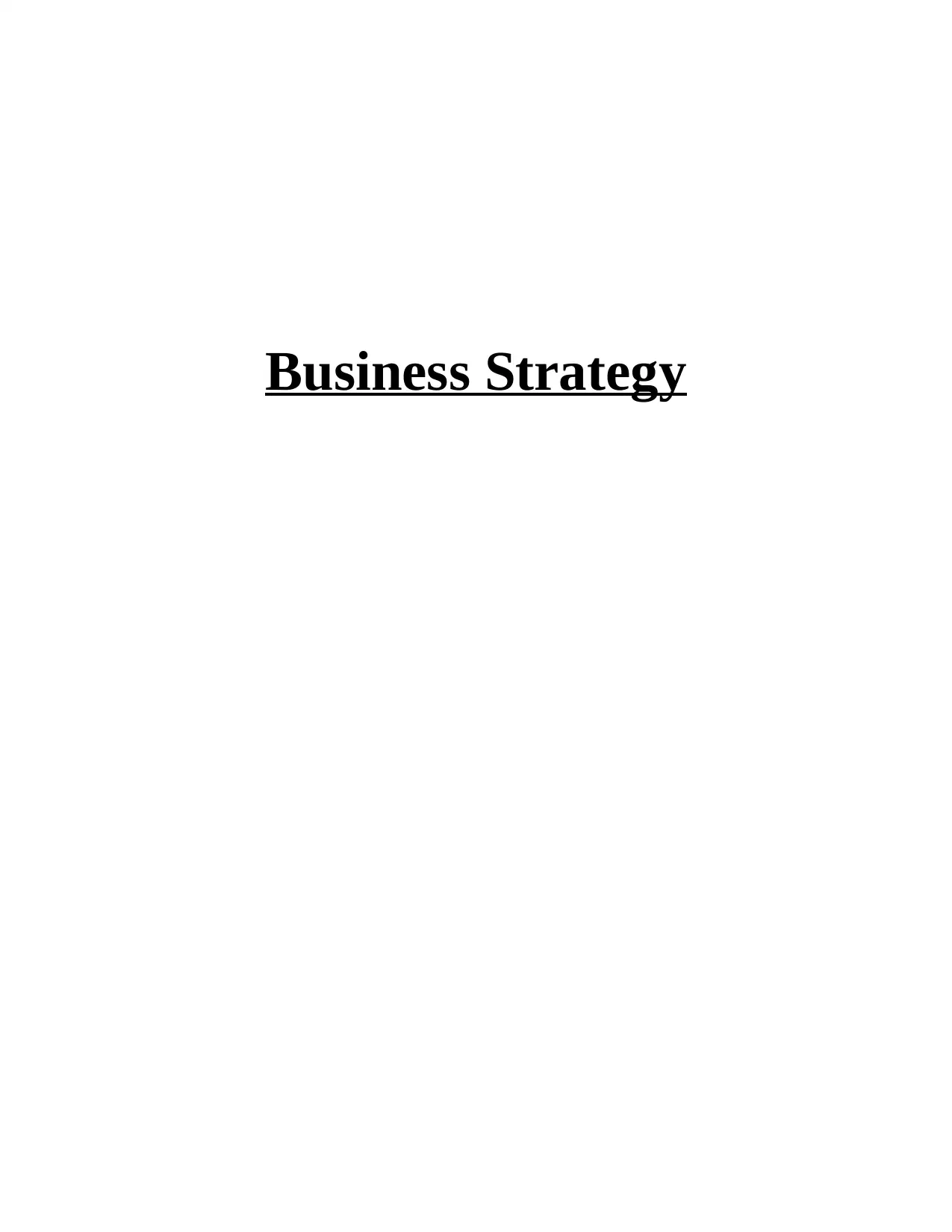
Business Strategy
Paraphrase This Document
Need a fresh take? Get an instant paraphrase of this document with our AI Paraphraser
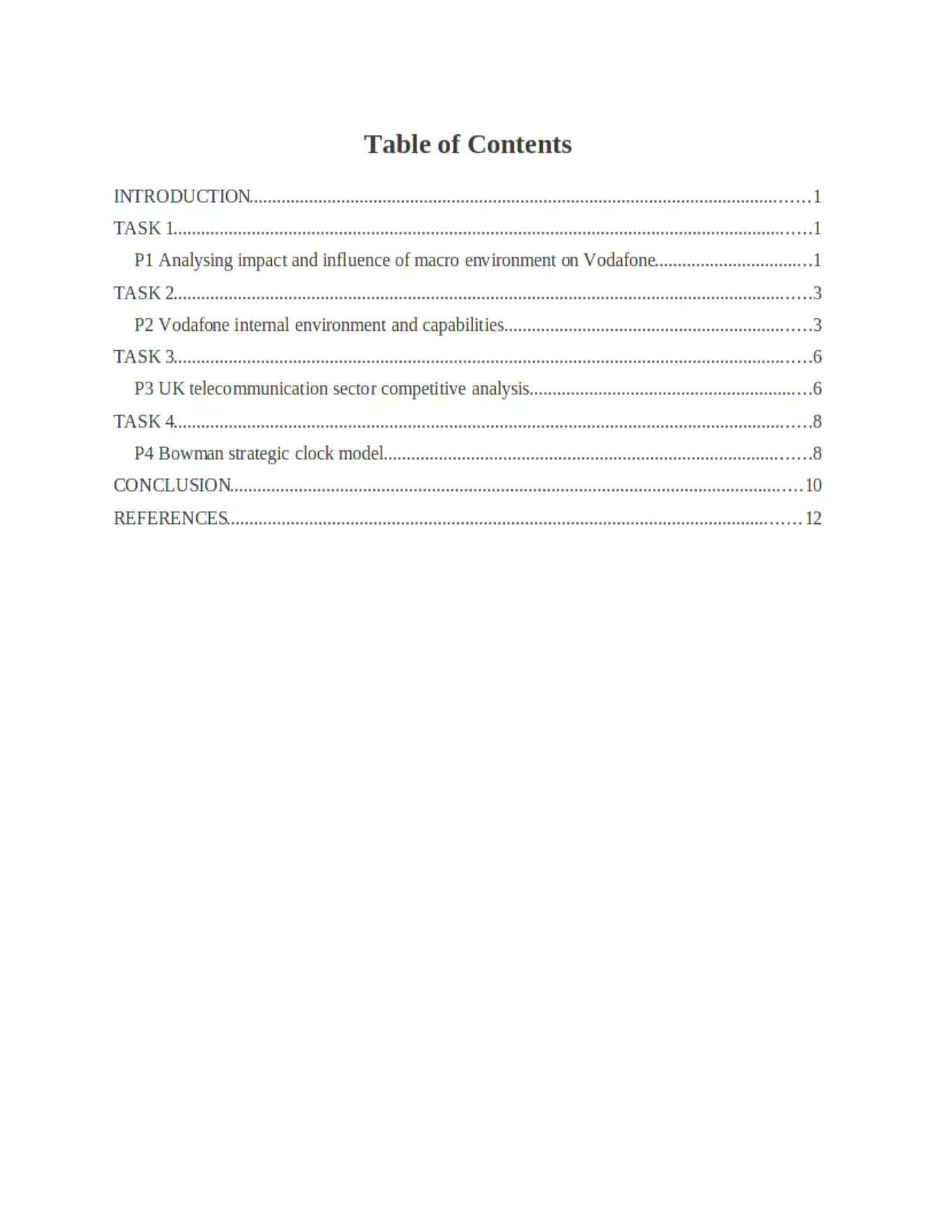
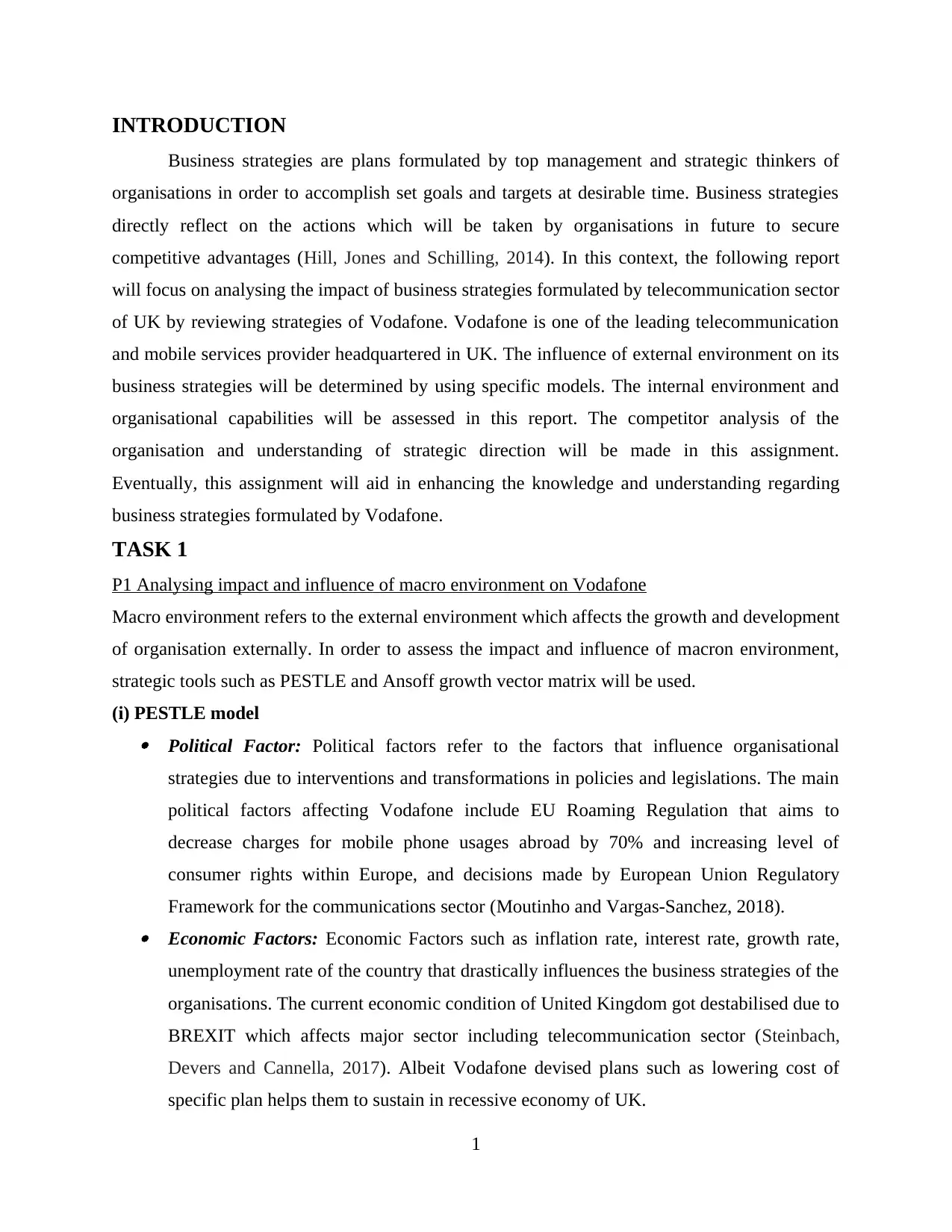
INTRODUCTION
Business strategies are plans formulated by top management and strategic thinkers of
organisations in order to accomplish set goals and targets at desirable time. Business strategies
directly reflect on the actions which will be taken by organisations in future to secure
competitive advantages (Hill, Jones and Schilling, 2014). In this context, the following report
will focus on analysing the impact of business strategies formulated by telecommunication sector
of UK by reviewing strategies of Vodafone. Vodafone is one of the leading telecommunication
and mobile services provider headquartered in UK. The influence of external environment on its
business strategies will be determined by using specific models. The internal environment and
organisational capabilities will be assessed in this report. The competitor analysis of the
organisation and understanding of strategic direction will be made in this assignment.
Eventually, this assignment will aid in enhancing the knowledge and understanding regarding
business strategies formulated by Vodafone.
TASK 1
P1 Analysing impact and influence of macro environment on Vodafone
Macro environment refers to the external environment which affects the growth and development
of organisation externally. In order to assess the impact and influence of macron environment,
strategic tools such as PESTLE and Ansoff growth vector matrix will be used.
(i) PESTLE model Political Factor: Political factors refer to the factors that influence organisational
strategies due to interventions and transformations in policies and legislations. The main
political factors affecting Vodafone include EU Roaming Regulation that aims to
decrease charges for mobile phone usages abroad by 70% and increasing level of
consumer rights within Europe, and decisions made by European Union Regulatory
Framework for the communications sector (Moutinho and Vargas-Sanchez, 2018). Economic Factors: Economic Factors such as inflation rate, interest rate, growth rate,
unemployment rate of the country that drastically influences the business strategies of the
organisations. The current economic condition of United Kingdom got destabilised due to
BREXIT which affects major sector including telecommunication sector (Steinbach,
Devers and Cannella, 2017). Albeit Vodafone devised plans such as lowering cost of
specific plan helps them to sustain in recessive economy of UK.
1
Business strategies are plans formulated by top management and strategic thinkers of
organisations in order to accomplish set goals and targets at desirable time. Business strategies
directly reflect on the actions which will be taken by organisations in future to secure
competitive advantages (Hill, Jones and Schilling, 2014). In this context, the following report
will focus on analysing the impact of business strategies formulated by telecommunication sector
of UK by reviewing strategies of Vodafone. Vodafone is one of the leading telecommunication
and mobile services provider headquartered in UK. The influence of external environment on its
business strategies will be determined by using specific models. The internal environment and
organisational capabilities will be assessed in this report. The competitor analysis of the
organisation and understanding of strategic direction will be made in this assignment.
Eventually, this assignment will aid in enhancing the knowledge and understanding regarding
business strategies formulated by Vodafone.
TASK 1
P1 Analysing impact and influence of macro environment on Vodafone
Macro environment refers to the external environment which affects the growth and development
of organisation externally. In order to assess the impact and influence of macron environment,
strategic tools such as PESTLE and Ansoff growth vector matrix will be used.
(i) PESTLE model Political Factor: Political factors refer to the factors that influence organisational
strategies due to interventions and transformations in policies and legislations. The main
political factors affecting Vodafone include EU Roaming Regulation that aims to
decrease charges for mobile phone usages abroad by 70% and increasing level of
consumer rights within Europe, and decisions made by European Union Regulatory
Framework for the communications sector (Moutinho and Vargas-Sanchez, 2018). Economic Factors: Economic Factors such as inflation rate, interest rate, growth rate,
unemployment rate of the country that drastically influences the business strategies of the
organisations. The current economic condition of United Kingdom got destabilised due to
BREXIT which affects major sector including telecommunication sector (Steinbach,
Devers and Cannella, 2017). Albeit Vodafone devised plans such as lowering cost of
specific plan helps them to sustain in recessive economy of UK.
1
⊘ This is a preview!⊘
Do you want full access?
Subscribe today to unlock all pages.

Trusted by 1+ million students worldwide
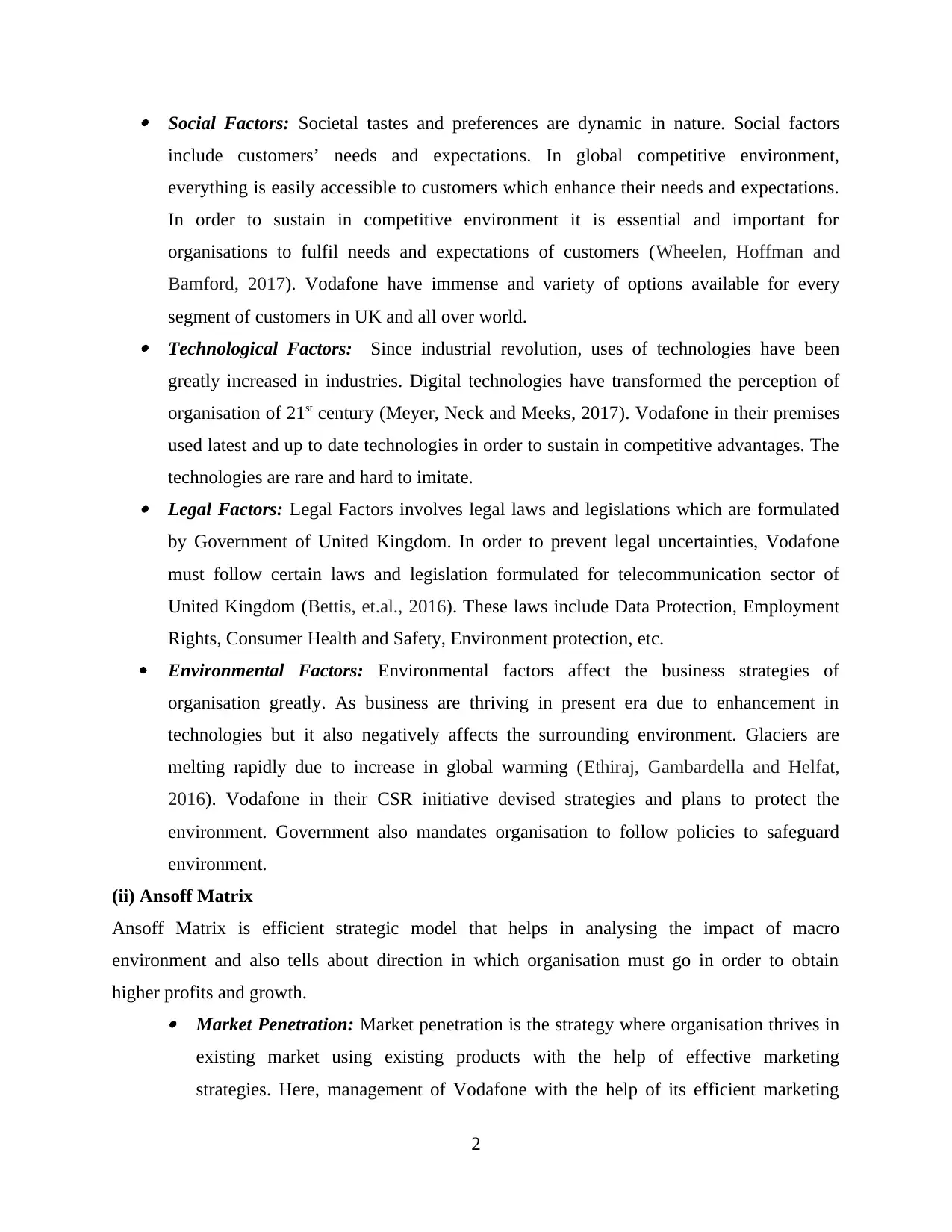
Social Factors: Societal tastes and preferences are dynamic in nature. Social factors
include customers’ needs and expectations. In global competitive environment,
everything is easily accessible to customers which enhance their needs and expectations.
In order to sustain in competitive environment it is essential and important for
organisations to fulfil needs and expectations of customers (Wheelen, Hoffman and
Bamford, 2017). Vodafone have immense and variety of options available for every
segment of customers in UK and all over world. Technological Factors: Since industrial revolution, uses of technologies have been
greatly increased in industries. Digital technologies have transformed the perception of
organisation of 21st century (Meyer, Neck and Meeks, 2017). Vodafone in their premises
used latest and up to date technologies in order to sustain in competitive advantages. The
technologies are rare and hard to imitate. Legal Factors: Legal Factors involves legal laws and legislations which are formulated
by Government of United Kingdom. In order to prevent legal uncertainties, Vodafone
must follow certain laws and legislation formulated for telecommunication sector of
United Kingdom (Bettis, et.al., 2016). These laws include Data Protection, Employment
Rights, Consumer Health and Safety, Environment protection, etc.
Environmental Factors: Environmental factors affect the business strategies of
organisation greatly. As business are thriving in present era due to enhancement in
technologies but it also negatively affects the surrounding environment. Glaciers are
melting rapidly due to increase in global warming (Ethiraj, Gambardella and Helfat,
2016). Vodafone in their CSR initiative devised strategies and plans to protect the
environment. Government also mandates organisation to follow policies to safeguard
environment.
(ii) Ansoff Matrix
Ansoff Matrix is efficient strategic model that helps in analysing the impact of macro
environment and also tells about direction in which organisation must go in order to obtain
higher profits and growth.
Market Penetration: Market penetration is the strategy where organisation thrives in
existing market using existing products with the help of effective marketing
strategies. Here, management of Vodafone with the help of its efficient marketing
2
include customers’ needs and expectations. In global competitive environment,
everything is easily accessible to customers which enhance their needs and expectations.
In order to sustain in competitive environment it is essential and important for
organisations to fulfil needs and expectations of customers (Wheelen, Hoffman and
Bamford, 2017). Vodafone have immense and variety of options available for every
segment of customers in UK and all over world. Technological Factors: Since industrial revolution, uses of technologies have been
greatly increased in industries. Digital technologies have transformed the perception of
organisation of 21st century (Meyer, Neck and Meeks, 2017). Vodafone in their premises
used latest and up to date technologies in order to sustain in competitive advantages. The
technologies are rare and hard to imitate. Legal Factors: Legal Factors involves legal laws and legislations which are formulated
by Government of United Kingdom. In order to prevent legal uncertainties, Vodafone
must follow certain laws and legislation formulated for telecommunication sector of
United Kingdom (Bettis, et.al., 2016). These laws include Data Protection, Employment
Rights, Consumer Health and Safety, Environment protection, etc.
Environmental Factors: Environmental factors affect the business strategies of
organisation greatly. As business are thriving in present era due to enhancement in
technologies but it also negatively affects the surrounding environment. Glaciers are
melting rapidly due to increase in global warming (Ethiraj, Gambardella and Helfat,
2016). Vodafone in their CSR initiative devised strategies and plans to protect the
environment. Government also mandates organisation to follow policies to safeguard
environment.
(ii) Ansoff Matrix
Ansoff Matrix is efficient strategic model that helps in analysing the impact of macro
environment and also tells about direction in which organisation must go in order to obtain
higher profits and growth.
Market Penetration: Market penetration is the strategy where organisation thrives in
existing market using existing products with the help of effective marketing
strategies. Here, management of Vodafone with the help of its efficient marketing
2
Paraphrase This Document
Need a fresh take? Get an instant paraphrase of this document with our AI Paraphraser
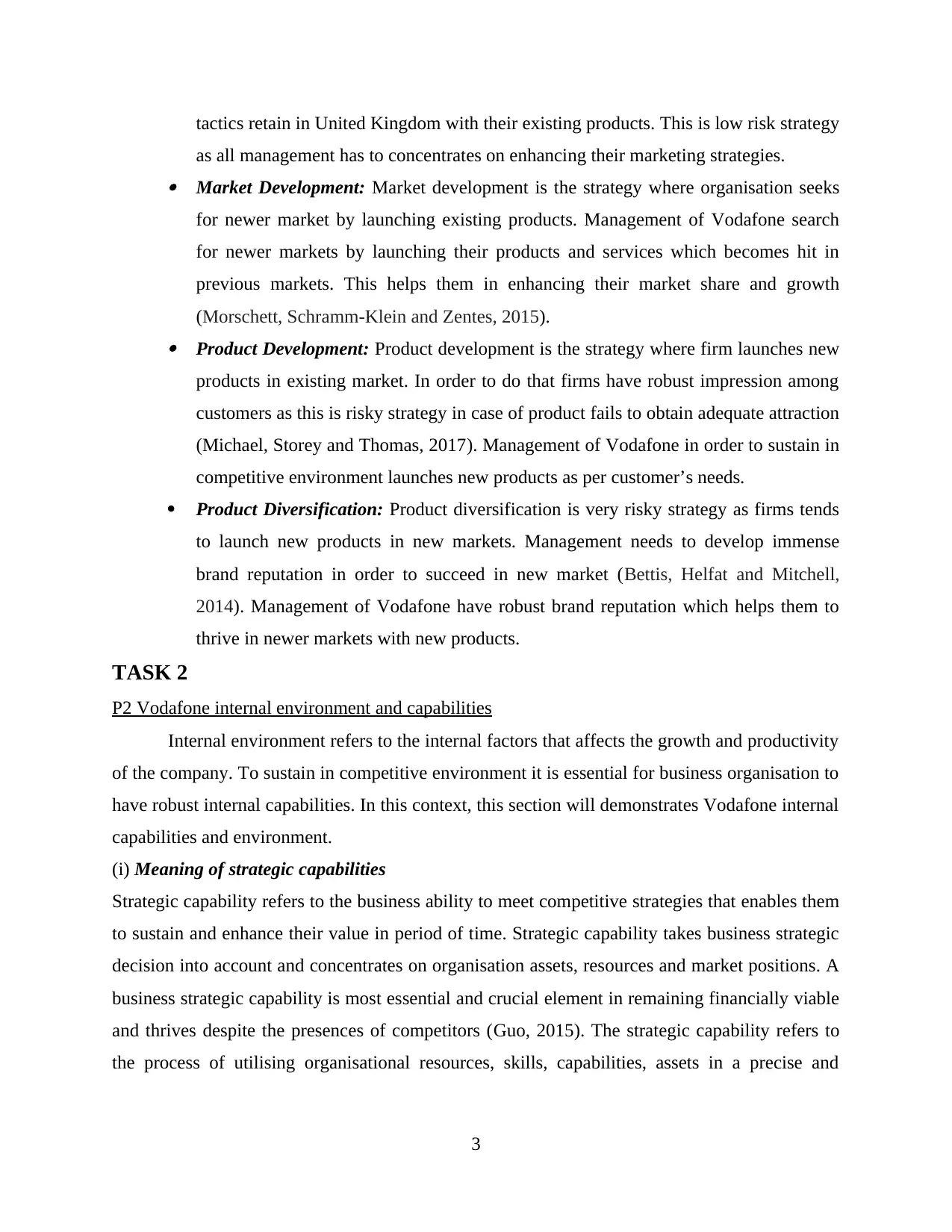
tactics retain in United Kingdom with their existing products. This is low risk strategy
as all management has to concentrates on enhancing their marketing strategies.
Market Development: Market development is the strategy where organisation seeks
for newer market by launching existing products. Management of Vodafone search
for newer markets by launching their products and services which becomes hit in
previous markets. This helps them in enhancing their market share and growth
(Morschett, Schramm-Klein and Zentes, 2015).
Product Development: Product development is the strategy where firm launches new
products in existing market. In order to do that firms have robust impression among
customers as this is risky strategy in case of product fails to obtain adequate attraction
(Michael, Storey and Thomas, 2017). Management of Vodafone in order to sustain in
competitive environment launches new products as per customer’s needs.
Product Diversification: Product diversification is very risky strategy as firms tends
to launch new products in new markets. Management needs to develop immense
brand reputation in order to succeed in new market (Bettis, Helfat and Mitchell,
2014). Management of Vodafone have robust brand reputation which helps them to
thrive in newer markets with new products.
TASK 2
P2 Vodafone internal environment and capabilities
Internal environment refers to the internal factors that affects the growth and productivity
of the company. To sustain in competitive environment it is essential for business organisation to
have robust internal capabilities. In this context, this section will demonstrates Vodafone internal
capabilities and environment.
(i) Meaning of strategic capabilities
Strategic capability refers to the business ability to meet competitive strategies that enables them
to sustain and enhance their value in period of time. Strategic capability takes business strategic
decision into account and concentrates on organisation assets, resources and market positions. A
business strategic capability is most essential and crucial element in remaining financially viable
and thrives despite the presences of competitors (Guo, 2015). The strategic capability refers to
the process of utilising organisational resources, skills, capabilities, assets in a precise and
3
as all management has to concentrates on enhancing their marketing strategies.
Market Development: Market development is the strategy where organisation seeks
for newer market by launching existing products. Management of Vodafone search
for newer markets by launching their products and services which becomes hit in
previous markets. This helps them in enhancing their market share and growth
(Morschett, Schramm-Klein and Zentes, 2015).
Product Development: Product development is the strategy where firm launches new
products in existing market. In order to do that firms have robust impression among
customers as this is risky strategy in case of product fails to obtain adequate attraction
(Michael, Storey and Thomas, 2017). Management of Vodafone in order to sustain in
competitive environment launches new products as per customer’s needs.
Product Diversification: Product diversification is very risky strategy as firms tends
to launch new products in new markets. Management needs to develop immense
brand reputation in order to succeed in new market (Bettis, Helfat and Mitchell,
2014). Management of Vodafone have robust brand reputation which helps them to
thrive in newer markets with new products.
TASK 2
P2 Vodafone internal environment and capabilities
Internal environment refers to the internal factors that affects the growth and productivity
of the company. To sustain in competitive environment it is essential for business organisation to
have robust internal capabilities. In this context, this section will demonstrates Vodafone internal
capabilities and environment.
(i) Meaning of strategic capabilities
Strategic capability refers to the business ability to meet competitive strategies that enables them
to sustain and enhance their value in period of time. Strategic capability takes business strategic
decision into account and concentrates on organisation assets, resources and market positions. A
business strategic capability is most essential and crucial element in remaining financially viable
and thrives despite the presences of competitors (Guo, 2015). The strategic capability refers to
the process of utilising organisational resources, skills, capabilities, assets in a precise and
3
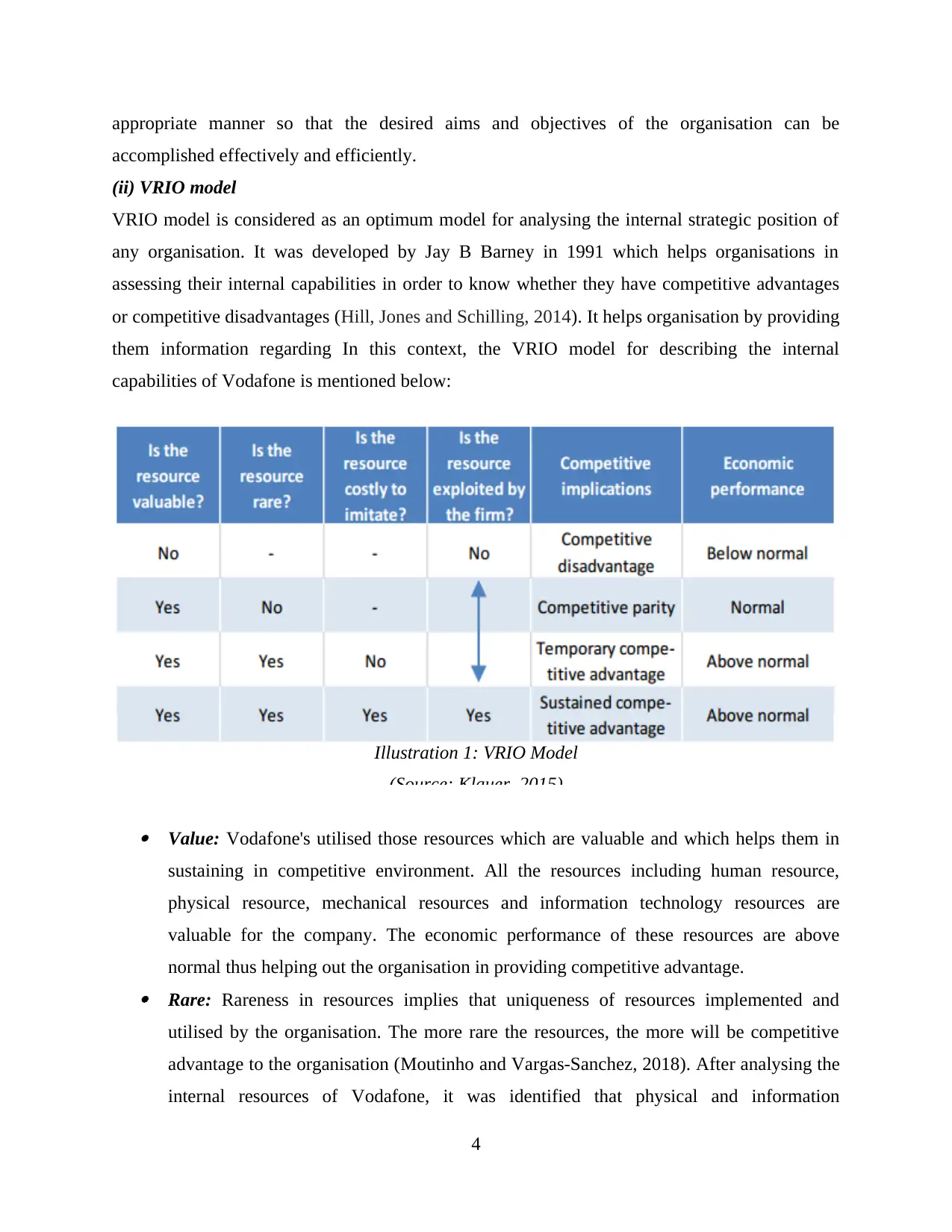
appropriate manner so that the desired aims and objectives of the organisation can be
accomplished effectively and efficiently.
(ii) VRIO model
VRIO model is considered as an optimum model for analysing the internal strategic position of
any organisation. It was developed by Jay B Barney in 1991 which helps organisations in
assessing their internal capabilities in order to know whether they have competitive advantages
or competitive disadvantages (Hill, Jones and Schilling, 2014). It helps organisation by providing
them information regarding In this context, the VRIO model for describing the internal
capabilities of Vodafone is mentioned below:
Value: Vodafone's utilised those resources which are valuable and which helps them in
sustaining in competitive environment. All the resources including human resource,
physical resource, mechanical resources and information technology resources are
valuable for the company. The economic performance of these resources are above
normal thus helping out the organisation in providing competitive advantage. Rare: Rareness in resources implies that uniqueness of resources implemented and
utilised by the organisation. The more rare the resources, the more will be competitive
advantage to the organisation (Moutinho and Vargas-Sanchez, 2018). After analysing the
internal resources of Vodafone, it was identified that physical and information
4
Illustration 1: VRIO Model
(Source: Klauer, 2015)
accomplished effectively and efficiently.
(ii) VRIO model
VRIO model is considered as an optimum model for analysing the internal strategic position of
any organisation. It was developed by Jay B Barney in 1991 which helps organisations in
assessing their internal capabilities in order to know whether they have competitive advantages
or competitive disadvantages (Hill, Jones and Schilling, 2014). It helps organisation by providing
them information regarding In this context, the VRIO model for describing the internal
capabilities of Vodafone is mentioned below:
Value: Vodafone's utilised those resources which are valuable and which helps them in
sustaining in competitive environment. All the resources including human resource,
physical resource, mechanical resources and information technology resources are
valuable for the company. The economic performance of these resources are above
normal thus helping out the organisation in providing competitive advantage. Rare: Rareness in resources implies that uniqueness of resources implemented and
utilised by the organisation. The more rare the resources, the more will be competitive
advantage to the organisation (Moutinho and Vargas-Sanchez, 2018). After analysing the
internal resources of Vodafone, it was identified that physical and information
4
Illustration 1: VRIO Model
(Source: Klauer, 2015)
⊘ This is a preview!⊘
Do you want full access?
Subscribe today to unlock all pages.

Trusted by 1+ million students worldwide
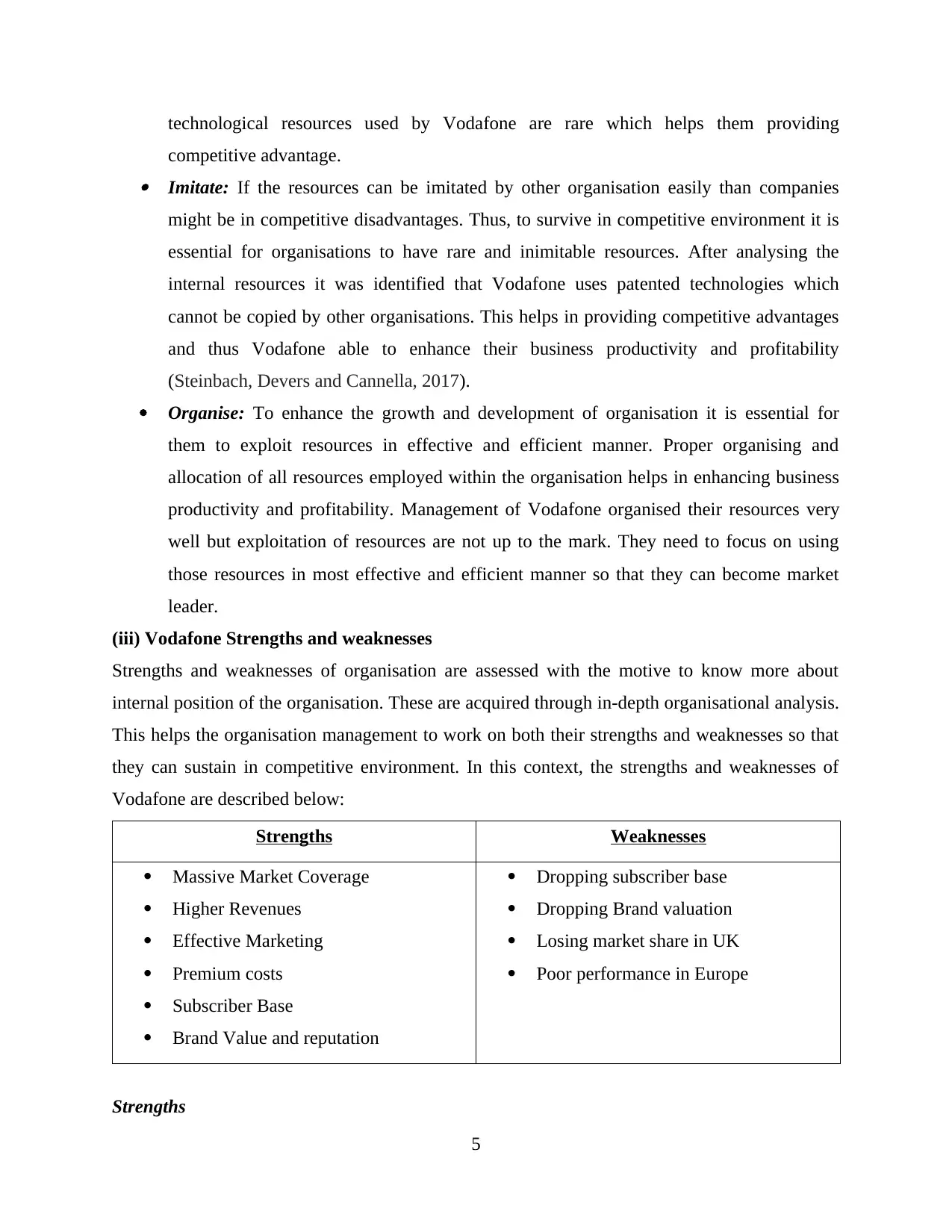
technological resources used by Vodafone are rare which helps them providing
competitive advantage. Imitate: If the resources can be imitated by other organisation easily than companies
might be in competitive disadvantages. Thus, to survive in competitive environment it is
essential for organisations to have rare and inimitable resources. After analysing the
internal resources it was identified that Vodafone uses patented technologies which
cannot be copied by other organisations. This helps in providing competitive advantages
and thus Vodafone able to enhance their business productivity and profitability
(Steinbach, Devers and Cannella, 2017).
Organise: To enhance the growth and development of organisation it is essential for
them to exploit resources in effective and efficient manner. Proper organising and
allocation of all resources employed within the organisation helps in enhancing business
productivity and profitability. Management of Vodafone organised their resources very
well but exploitation of resources are not up to the mark. They need to focus on using
those resources in most effective and efficient manner so that they can become market
leader.
(iii) Vodafone Strengths and weaknesses
Strengths and weaknesses of organisation are assessed with the motive to know more about
internal position of the organisation. These are acquired through in-depth organisational analysis.
This helps the organisation management to work on both their strengths and weaknesses so that
they can sustain in competitive environment. In this context, the strengths and weaknesses of
Vodafone are described below:
Strengths Weaknesses
Massive Market Coverage
Higher Revenues
Effective Marketing
Premium costs
Subscriber Base
Brand Value and reputation
Dropping subscriber base
Dropping Brand valuation
Losing market share in UK
Poor performance in Europe
Strengths
5
competitive advantage. Imitate: If the resources can be imitated by other organisation easily than companies
might be in competitive disadvantages. Thus, to survive in competitive environment it is
essential for organisations to have rare and inimitable resources. After analysing the
internal resources it was identified that Vodafone uses patented technologies which
cannot be copied by other organisations. This helps in providing competitive advantages
and thus Vodafone able to enhance their business productivity and profitability
(Steinbach, Devers and Cannella, 2017).
Organise: To enhance the growth and development of organisation it is essential for
them to exploit resources in effective and efficient manner. Proper organising and
allocation of all resources employed within the organisation helps in enhancing business
productivity and profitability. Management of Vodafone organised their resources very
well but exploitation of resources are not up to the mark. They need to focus on using
those resources in most effective and efficient manner so that they can become market
leader.
(iii) Vodafone Strengths and weaknesses
Strengths and weaknesses of organisation are assessed with the motive to know more about
internal position of the organisation. These are acquired through in-depth organisational analysis.
This helps the organisation management to work on both their strengths and weaknesses so that
they can sustain in competitive environment. In this context, the strengths and weaknesses of
Vodafone are described below:
Strengths Weaknesses
Massive Market Coverage
Higher Revenues
Effective Marketing
Premium costs
Subscriber Base
Brand Value and reputation
Dropping subscriber base
Dropping Brand valuation
Losing market share in UK
Poor performance in Europe
Strengths
5
Paraphrase This Document
Need a fresh take? Get an instant paraphrase of this document with our AI Paraphraser
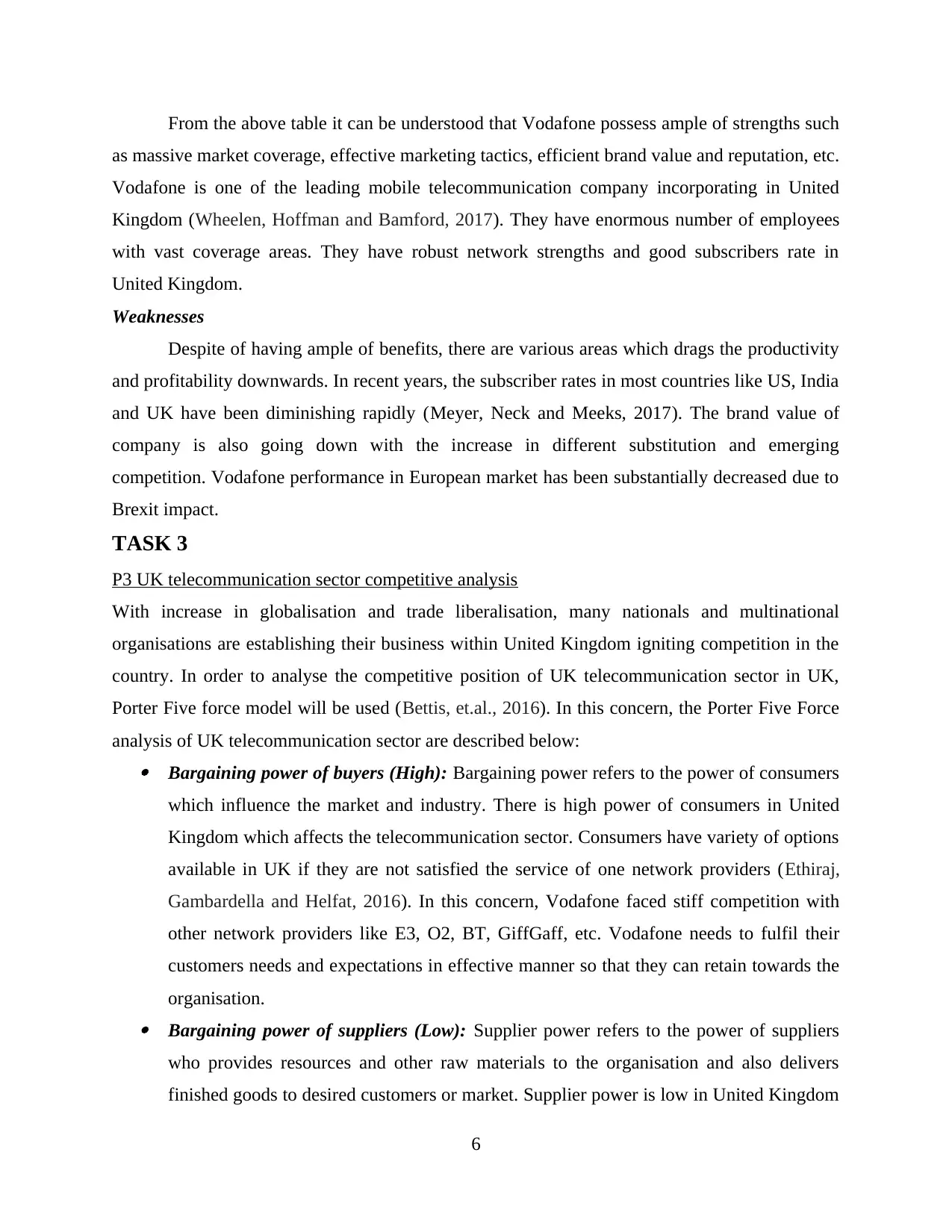
From the above table it can be understood that Vodafone possess ample of strengths such
as massive market coverage, effective marketing tactics, efficient brand value and reputation, etc.
Vodafone is one of the leading mobile telecommunication company incorporating in United
Kingdom (Wheelen, Hoffman and Bamford, 2017). They have enormous number of employees
with vast coverage areas. They have robust network strengths and good subscribers rate in
United Kingdom.
Weaknesses
Despite of having ample of benefits, there are various areas which drags the productivity
and profitability downwards. In recent years, the subscriber rates in most countries like US, India
and UK have been diminishing rapidly (Meyer, Neck and Meeks, 2017). The brand value of
company is also going down with the increase in different substitution and emerging
competition. Vodafone performance in European market has been substantially decreased due to
Brexit impact.
TASK 3
P3 UK telecommunication sector competitive analysis
With increase in globalisation and trade liberalisation, many nationals and multinational
organisations are establishing their business within United Kingdom igniting competition in the
country. In order to analyse the competitive position of UK telecommunication sector in UK,
Porter Five force model will be used (Bettis, et.al., 2016). In this concern, the Porter Five Force
analysis of UK telecommunication sector are described below: Bargaining power of buyers (High): Bargaining power refers to the power of consumers
which influence the market and industry. There is high power of consumers in United
Kingdom which affects the telecommunication sector. Consumers have variety of options
available in UK if they are not satisfied the service of one network providers (Ethiraj,
Gambardella and Helfat, 2016). In this concern, Vodafone faced stiff competition with
other network providers like E3, O2, BT, GiffGaff, etc. Vodafone needs to fulfil their
customers needs and expectations in effective manner so that they can retain towards the
organisation. Bargaining power of suppliers (Low): Supplier power refers to the power of suppliers
who provides resources and other raw materials to the organisation and also delivers
finished goods to desired customers or market. Supplier power is low in United Kingdom
6
as massive market coverage, effective marketing tactics, efficient brand value and reputation, etc.
Vodafone is one of the leading mobile telecommunication company incorporating in United
Kingdom (Wheelen, Hoffman and Bamford, 2017). They have enormous number of employees
with vast coverage areas. They have robust network strengths and good subscribers rate in
United Kingdom.
Weaknesses
Despite of having ample of benefits, there are various areas which drags the productivity
and profitability downwards. In recent years, the subscriber rates in most countries like US, India
and UK have been diminishing rapidly (Meyer, Neck and Meeks, 2017). The brand value of
company is also going down with the increase in different substitution and emerging
competition. Vodafone performance in European market has been substantially decreased due to
Brexit impact.
TASK 3
P3 UK telecommunication sector competitive analysis
With increase in globalisation and trade liberalisation, many nationals and multinational
organisations are establishing their business within United Kingdom igniting competition in the
country. In order to analyse the competitive position of UK telecommunication sector in UK,
Porter Five force model will be used (Bettis, et.al., 2016). In this concern, the Porter Five Force
analysis of UK telecommunication sector are described below: Bargaining power of buyers (High): Bargaining power refers to the power of consumers
which influence the market and industry. There is high power of consumers in United
Kingdom which affects the telecommunication sector. Consumers have variety of options
available in UK if they are not satisfied the service of one network providers (Ethiraj,
Gambardella and Helfat, 2016). In this concern, Vodafone faced stiff competition with
other network providers like E3, O2, BT, GiffGaff, etc. Vodafone needs to fulfil their
customers needs and expectations in effective manner so that they can retain towards the
organisation. Bargaining power of suppliers (Low): Supplier power refers to the power of suppliers
who provides resources and other raw materials to the organisation and also delivers
finished goods to desired customers or market. Supplier power is low in United Kingdom
6
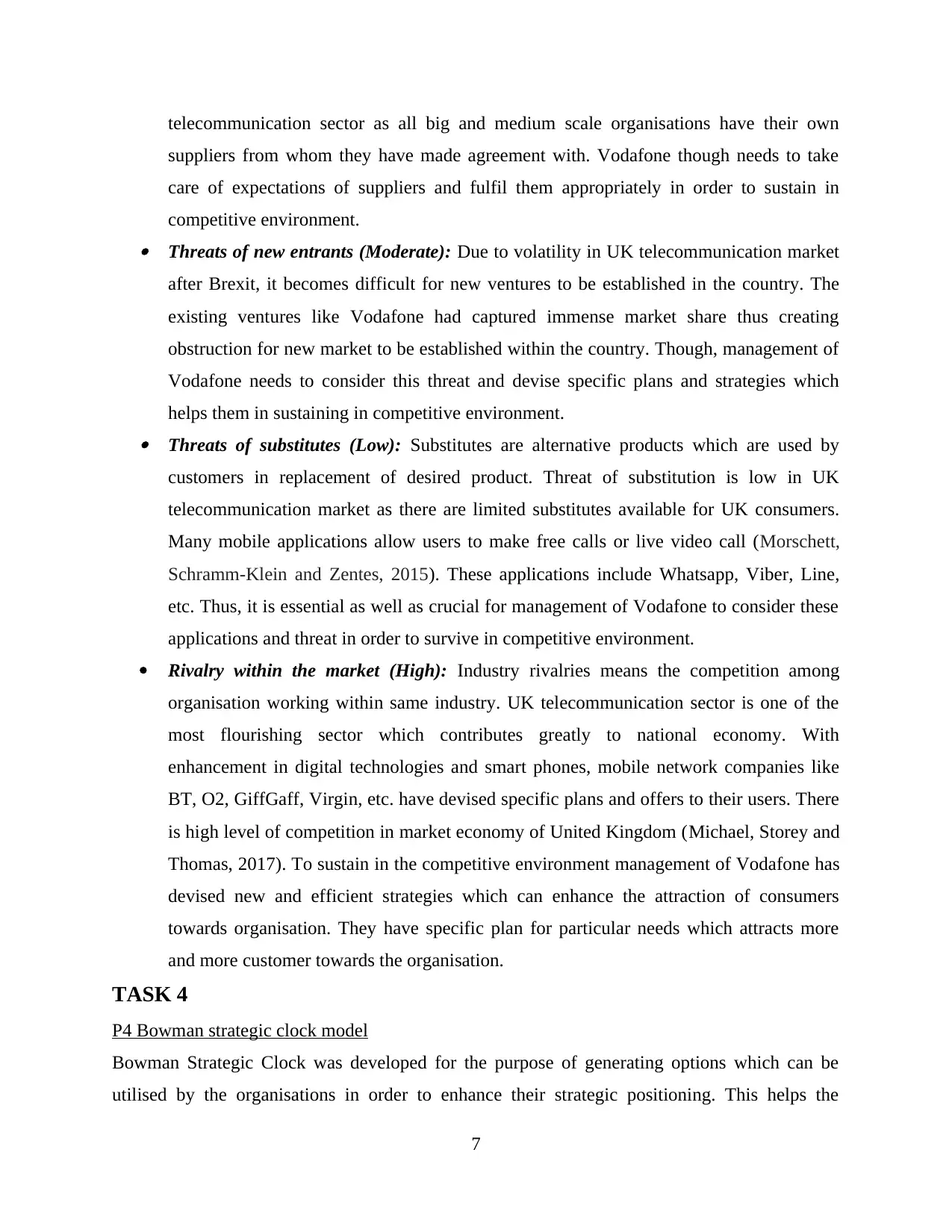
telecommunication sector as all big and medium scale organisations have their own
suppliers from whom they have made agreement with. Vodafone though needs to take
care of expectations of suppliers and fulfil them appropriately in order to sustain in
competitive environment. Threats of new entrants (Moderate): Due to volatility in UK telecommunication market
after Brexit, it becomes difficult for new ventures to be established in the country. The
existing ventures like Vodafone had captured immense market share thus creating
obstruction for new market to be established within the country. Though, management of
Vodafone needs to consider this threat and devise specific plans and strategies which
helps them in sustaining in competitive environment. Threats of substitutes (Low): Substitutes are alternative products which are used by
customers in replacement of desired product. Threat of substitution is low in UK
telecommunication market as there are limited substitutes available for UK consumers.
Many mobile applications allow users to make free calls or live video call (Morschett,
Schramm-Klein and Zentes, 2015). These applications include Whatsapp, Viber, Line,
etc. Thus, it is essential as well as crucial for management of Vodafone to consider these
applications and threat in order to survive in competitive environment.
Rivalry within the market (High): Industry rivalries means the competition among
organisation working within same industry. UK telecommunication sector is one of the
most flourishing sector which contributes greatly to national economy. With
enhancement in digital technologies and smart phones, mobile network companies like
BT, O2, GiffGaff, Virgin, etc. have devised specific plans and offers to their users. There
is high level of competition in market economy of United Kingdom (Michael, Storey and
Thomas, 2017). To sustain in the competitive environment management of Vodafone has
devised new and efficient strategies which can enhance the attraction of consumers
towards organisation. They have specific plan for particular needs which attracts more
and more customer towards the organisation.
TASK 4
P4 Bowman strategic clock model
Bowman Strategic Clock was developed for the purpose of generating options which can be
utilised by the organisations in order to enhance their strategic positioning. This helps the
7
suppliers from whom they have made agreement with. Vodafone though needs to take
care of expectations of suppliers and fulfil them appropriately in order to sustain in
competitive environment. Threats of new entrants (Moderate): Due to volatility in UK telecommunication market
after Brexit, it becomes difficult for new ventures to be established in the country. The
existing ventures like Vodafone had captured immense market share thus creating
obstruction for new market to be established within the country. Though, management of
Vodafone needs to consider this threat and devise specific plans and strategies which
helps them in sustaining in competitive environment. Threats of substitutes (Low): Substitutes are alternative products which are used by
customers in replacement of desired product. Threat of substitution is low in UK
telecommunication market as there are limited substitutes available for UK consumers.
Many mobile applications allow users to make free calls or live video call (Morschett,
Schramm-Klein and Zentes, 2015). These applications include Whatsapp, Viber, Line,
etc. Thus, it is essential as well as crucial for management of Vodafone to consider these
applications and threat in order to survive in competitive environment.
Rivalry within the market (High): Industry rivalries means the competition among
organisation working within same industry. UK telecommunication sector is one of the
most flourishing sector which contributes greatly to national economy. With
enhancement in digital technologies and smart phones, mobile network companies like
BT, O2, GiffGaff, Virgin, etc. have devised specific plans and offers to their users. There
is high level of competition in market economy of United Kingdom (Michael, Storey and
Thomas, 2017). To sustain in the competitive environment management of Vodafone has
devised new and efficient strategies which can enhance the attraction of consumers
towards organisation. They have specific plan for particular needs which attracts more
and more customer towards the organisation.
TASK 4
P4 Bowman strategic clock model
Bowman Strategic Clock was developed for the purpose of generating options which can be
utilised by the organisations in order to enhance their strategic positioning. This helps the
7
⊘ This is a preview!⊘
Do you want full access?
Subscribe today to unlock all pages.

Trusted by 1+ million students worldwide
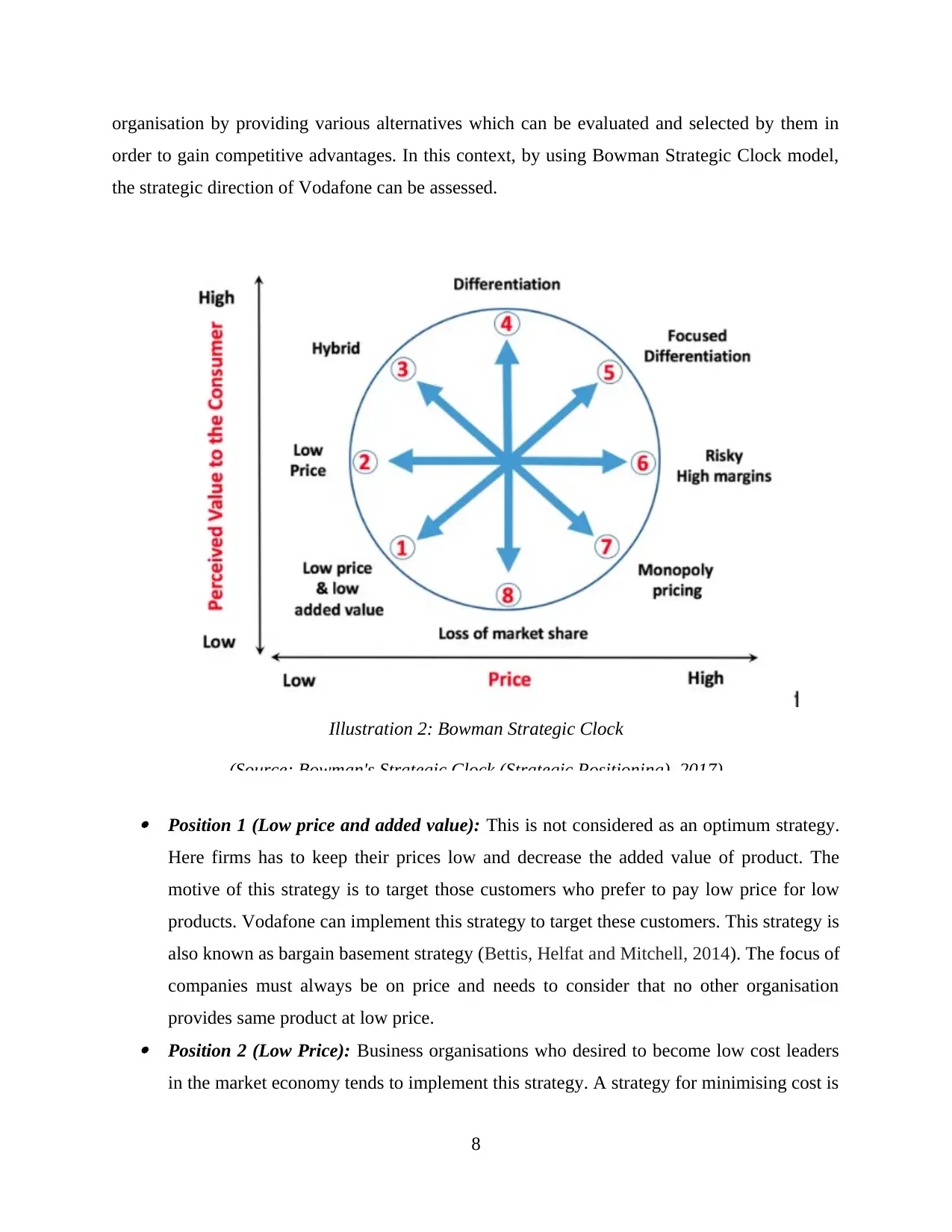
organisation by providing various alternatives which can be evaluated and selected by them in
order to gain competitive advantages. In this context, by using Bowman Strategic Clock model,
the strategic direction of Vodafone can be assessed.
Position 1 (Low price and added value): This is not considered as an optimum strategy.
Here firms has to keep their prices low and decrease the added value of product. The
motive of this strategy is to target those customers who prefer to pay low price for low
products. Vodafone can implement this strategy to target these customers. This strategy is
also known as bargain basement strategy (Bettis, Helfat and Mitchell, 2014). The focus of
companies must always be on price and needs to consider that no other organisation
provides same product at low price. Position 2 (Low Price): Business organisations who desired to become low cost leaders
in the market economy tends to implement this strategy. A strategy for minimising cost is
8
Illustration 2: Bowman Strategic Clock
(Source: Bowman's Strategic Clock (Strategic Positioning), 2017)
order to gain competitive advantages. In this context, by using Bowman Strategic Clock model,
the strategic direction of Vodafone can be assessed.
Position 1 (Low price and added value): This is not considered as an optimum strategy.
Here firms has to keep their prices low and decrease the added value of product. The
motive of this strategy is to target those customers who prefer to pay low price for low
products. Vodafone can implement this strategy to target these customers. This strategy is
also known as bargain basement strategy (Bettis, Helfat and Mitchell, 2014). The focus of
companies must always be on price and needs to consider that no other organisation
provides same product at low price. Position 2 (Low Price): Business organisations who desired to become low cost leaders
in the market economy tends to implement this strategy. A strategy for minimising cost is
8
Illustration 2: Bowman Strategic Clock
(Source: Bowman's Strategic Clock (Strategic Positioning), 2017)
Paraphrase This Document
Need a fresh take? Get an instant paraphrase of this document with our AI Paraphraser
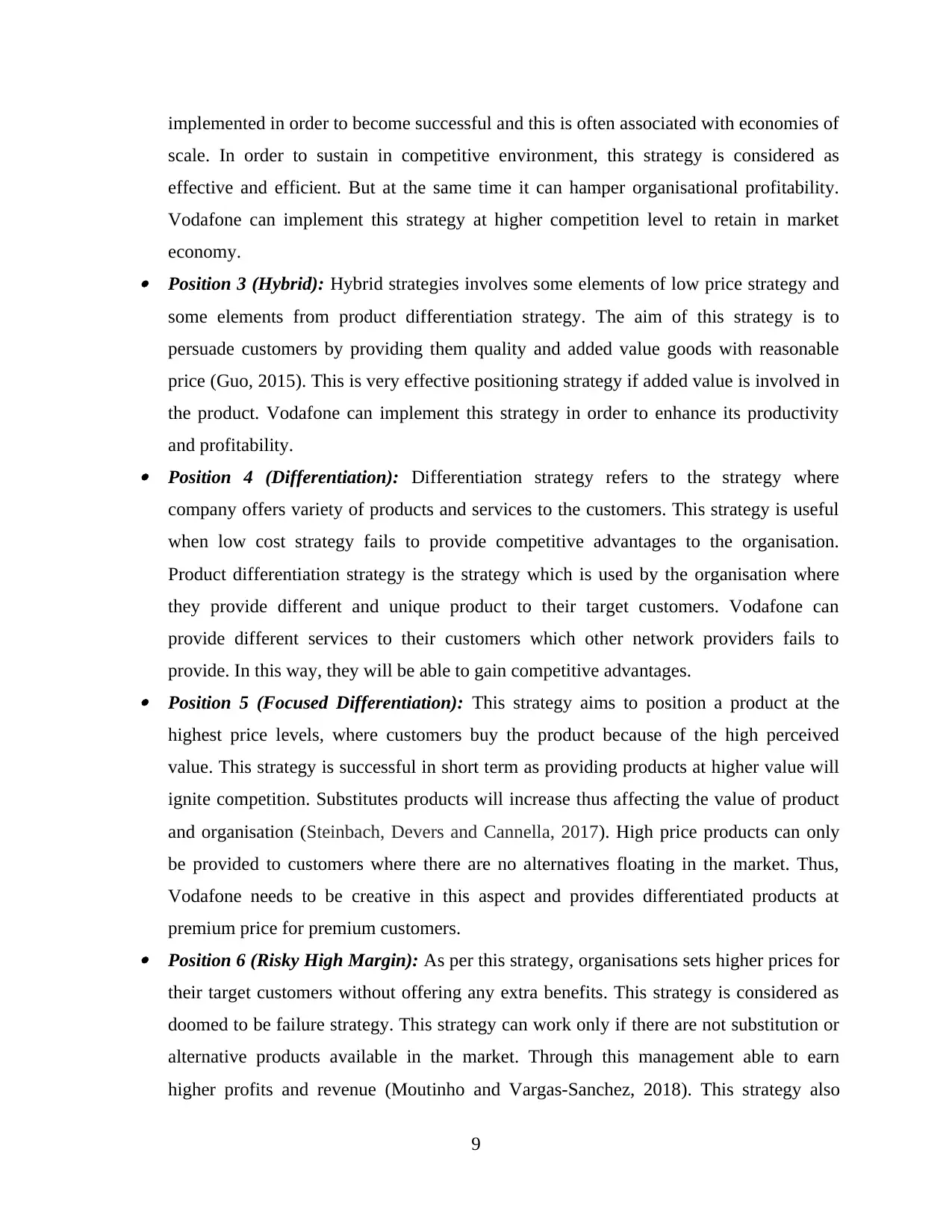
implemented in order to become successful and this is often associated with economies of
scale. In order to sustain in competitive environment, this strategy is considered as
effective and efficient. But at the same time it can hamper organisational profitability.
Vodafone can implement this strategy at higher competition level to retain in market
economy. Position 3 (Hybrid): Hybrid strategies involves some elements of low price strategy and
some elements from product differentiation strategy. The aim of this strategy is to
persuade customers by providing them quality and added value goods with reasonable
price (Guo, 2015). This is very effective positioning strategy if added value is involved in
the product. Vodafone can implement this strategy in order to enhance its productivity
and profitability. Position 4 (Differentiation): Differentiation strategy refers to the strategy where
company offers variety of products and services to the customers. This strategy is useful
when low cost strategy fails to provide competitive advantages to the organisation.
Product differentiation strategy is the strategy which is used by the organisation where
they provide different and unique product to their target customers. Vodafone can
provide different services to their customers which other network providers fails to
provide. In this way, they will be able to gain competitive advantages. Position 5 (Focused Differentiation): This strategy aims to position a product at the
highest price levels, where customers buy the product because of the high perceived
value. This strategy is successful in short term as providing products at higher value will
ignite competition. Substitutes products will increase thus affecting the value of product
and organisation (Steinbach, Devers and Cannella, 2017). High price products can only
be provided to customers where there are no alternatives floating in the market. Thus,
Vodafone needs to be creative in this aspect and provides differentiated products at
premium price for premium customers. Position 6 (Risky High Margin): As per this strategy, organisations sets higher prices for
their target customers without offering any extra benefits. This strategy is considered as
doomed to be failure strategy. This strategy can work only if there are not substitution or
alternative products available in the market. Through this management able to earn
higher profits and revenue (Moutinho and Vargas-Sanchez, 2018). This strategy also
9
scale. In order to sustain in competitive environment, this strategy is considered as
effective and efficient. But at the same time it can hamper organisational profitability.
Vodafone can implement this strategy at higher competition level to retain in market
economy. Position 3 (Hybrid): Hybrid strategies involves some elements of low price strategy and
some elements from product differentiation strategy. The aim of this strategy is to
persuade customers by providing them quality and added value goods with reasonable
price (Guo, 2015). This is very effective positioning strategy if added value is involved in
the product. Vodafone can implement this strategy in order to enhance its productivity
and profitability. Position 4 (Differentiation): Differentiation strategy refers to the strategy where
company offers variety of products and services to the customers. This strategy is useful
when low cost strategy fails to provide competitive advantages to the organisation.
Product differentiation strategy is the strategy which is used by the organisation where
they provide different and unique product to their target customers. Vodafone can
provide different services to their customers which other network providers fails to
provide. In this way, they will be able to gain competitive advantages. Position 5 (Focused Differentiation): This strategy aims to position a product at the
highest price levels, where customers buy the product because of the high perceived
value. This strategy is successful in short term as providing products at higher value will
ignite competition. Substitutes products will increase thus affecting the value of product
and organisation (Steinbach, Devers and Cannella, 2017). High price products can only
be provided to customers where there are no alternatives floating in the market. Thus,
Vodafone needs to be creative in this aspect and provides differentiated products at
premium price for premium customers. Position 6 (Risky High Margin): As per this strategy, organisations sets higher prices for
their target customers without offering any extra benefits. This strategy is considered as
doomed to be failure strategy. This strategy can work only if there are not substitution or
alternative products available in the market. Through this management able to earn
higher profits and revenue (Moutinho and Vargas-Sanchez, 2018). This strategy also
9
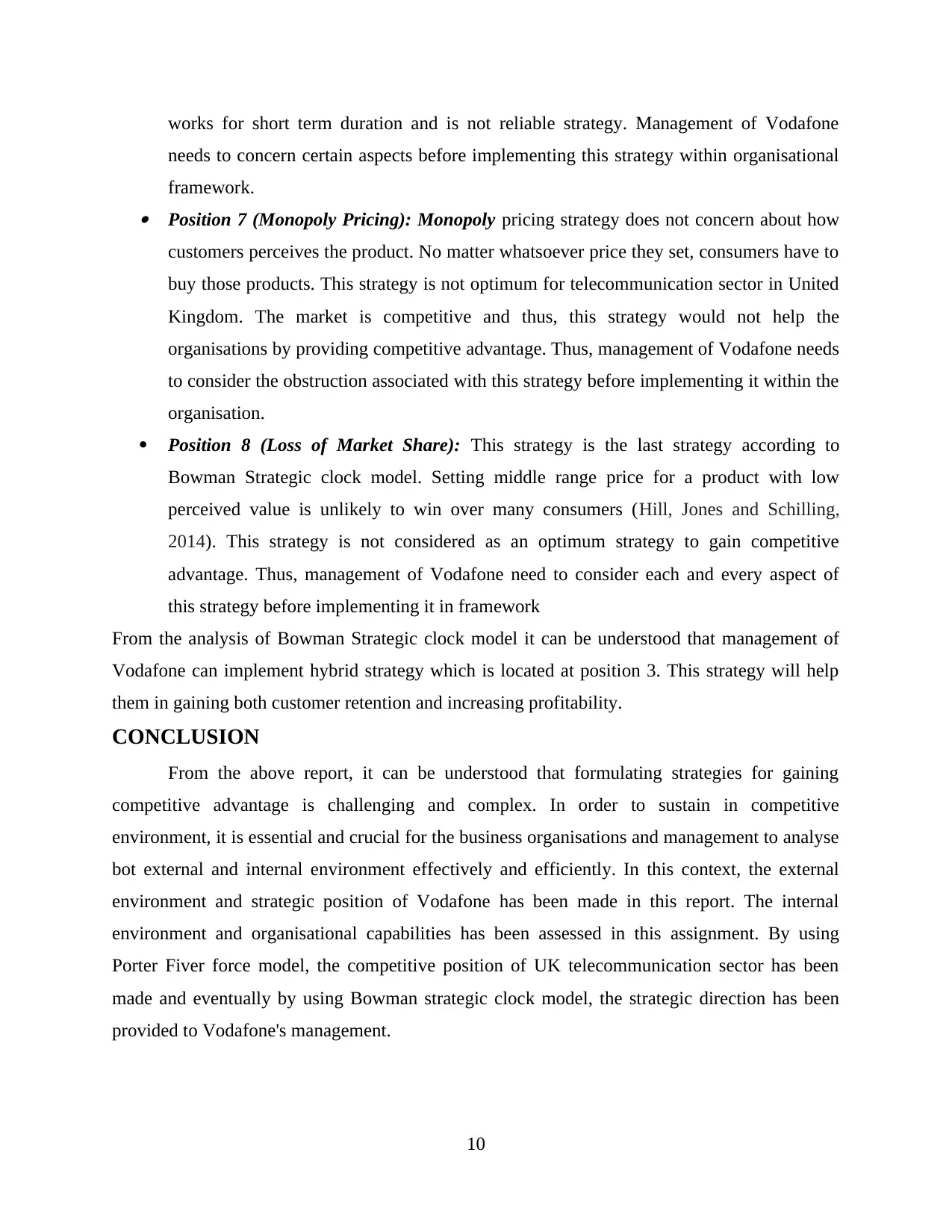
works for short term duration and is not reliable strategy. Management of Vodafone
needs to concern certain aspects before implementing this strategy within organisational
framework. Position 7 (Monopoly Pricing): Monopoly pricing strategy does not concern about how
customers perceives the product. No matter whatsoever price they set, consumers have to
buy those products. This strategy is not optimum for telecommunication sector in United
Kingdom. The market is competitive and thus, this strategy would not help the
organisations by providing competitive advantage. Thus, management of Vodafone needs
to consider the obstruction associated with this strategy before implementing it within the
organisation.
Position 8 (Loss of Market Share): This strategy is the last strategy according to
Bowman Strategic clock model. Setting middle range price for a product with low
perceived value is unlikely to win over many consumers (Hill, Jones and Schilling,
2014). This strategy is not considered as an optimum strategy to gain competitive
advantage. Thus, management of Vodafone need to consider each and every aspect of
this strategy before implementing it in framework
From the analysis of Bowman Strategic clock model it can be understood that management of
Vodafone can implement hybrid strategy which is located at position 3. This strategy will help
them in gaining both customer retention and increasing profitability.
CONCLUSION
From the above report, it can be understood that formulating strategies for gaining
competitive advantage is challenging and complex. In order to sustain in competitive
environment, it is essential and crucial for the business organisations and management to analyse
bot external and internal environment effectively and efficiently. In this context, the external
environment and strategic position of Vodafone has been made in this report. The internal
environment and organisational capabilities has been assessed in this assignment. By using
Porter Fiver force model, the competitive position of UK telecommunication sector has been
made and eventually by using Bowman strategic clock model, the strategic direction has been
provided to Vodafone's management.
10
needs to concern certain aspects before implementing this strategy within organisational
framework. Position 7 (Monopoly Pricing): Monopoly pricing strategy does not concern about how
customers perceives the product. No matter whatsoever price they set, consumers have to
buy those products. This strategy is not optimum for telecommunication sector in United
Kingdom. The market is competitive and thus, this strategy would not help the
organisations by providing competitive advantage. Thus, management of Vodafone needs
to consider the obstruction associated with this strategy before implementing it within the
organisation.
Position 8 (Loss of Market Share): This strategy is the last strategy according to
Bowman Strategic clock model. Setting middle range price for a product with low
perceived value is unlikely to win over many consumers (Hill, Jones and Schilling,
2014). This strategy is not considered as an optimum strategy to gain competitive
advantage. Thus, management of Vodafone need to consider each and every aspect of
this strategy before implementing it in framework
From the analysis of Bowman Strategic clock model it can be understood that management of
Vodafone can implement hybrid strategy which is located at position 3. This strategy will help
them in gaining both customer retention and increasing profitability.
CONCLUSION
From the above report, it can be understood that formulating strategies for gaining
competitive advantage is challenging and complex. In order to sustain in competitive
environment, it is essential and crucial for the business organisations and management to analyse
bot external and internal environment effectively and efficiently. In this context, the external
environment and strategic position of Vodafone has been made in this report. The internal
environment and organisational capabilities has been assessed in this assignment. By using
Porter Fiver force model, the competitive position of UK telecommunication sector has been
made and eventually by using Bowman strategic clock model, the strategic direction has been
provided to Vodafone's management.
10
⊘ This is a preview!⊘
Do you want full access?
Subscribe today to unlock all pages.

Trusted by 1+ million students worldwide
1 out of 14
Related Documents
Your All-in-One AI-Powered Toolkit for Academic Success.
+13062052269
info@desklib.com
Available 24*7 on WhatsApp / Email
![[object Object]](/_next/static/media/star-bottom.7253800d.svg)
Unlock your academic potential
Copyright © 2020–2025 A2Z Services. All Rights Reserved. Developed and managed by ZUCOL.




